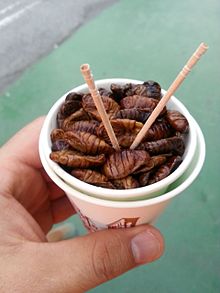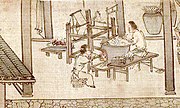Sericulture

Sericulture, or silk farming, is the cultivation of
History
According to
- Traditional Chinese process
-
The silkworms and mulberry leaves are placed on trays.
-
Twig frames for the silkworms are prepared.
-
The cocoons are weighed.
-
The cocoons are boiled and the silk is wound on spools.
-
The silk is woven using a loom.
Production
The silkworms are fed with
Single filaments are combined to form
Sustainable silk
Peace silk
The most popular substitute for traditional silk is peace silk, also known as ahimsa silk. The primary factor that makes this form of silk more ethical is that moths are permitted to emerge from their cocoons and fly away prior to boiling. It denotes that no pupa is ever cooked alive during manufacture. However, there is a big disadvantage to be aware of. Domesticated silkworms used to make silk have undergone thousands of years of selective breeding, yet they are not "manufactured" to emerge from their cocoons. They are unable to defend themselves against predators since they cannot fly or see clearly. They typically die very rapidly after emerging from their cocoons as a result.[10]
Wild silk
The cocoons of Tussar silkworms, which are found in open woodlands, are used to produce wild silk, also known as Tussar silk. Compared to conventional silk, their cocoons are typically picked after the moths have emerged, making it a more ethical option. Because wild silkworms consume a variety of plants, their fabric is less uniform but more robust. The fabric is made with fewer chemicals as well. The pupae are still inside the cocoons when they are harvested by certain enterprises that employ "wild silk", though.[11]
Stages of production
The stages of production are as follows:
- The female silkmoth lays 300 to 500 eggs.
- The silkmoth eggs hatch to form larvae or caterpillars, known as silkworms.
- The larvae feed on mulberry leaves.
- Having grown and moulted several times, the silkworm extrudes a silk fibre and forms a net to hold itself.
- It swings itself from side to side in a figure '8', distributing the saliva that will form silk.
- The silk solidifies when it contacts the air.
- The silkworm spins approximately one mile of filament and completely encloses itself in a cocoon in about two or three days. The amount of usable quality silk in each cocoon is small. As a result, about 2,500 silkworms are required to produce a pound of raw silk.[12]
- The intact cocoons are boiled, killing the silkworm pupa.
- The silk is obtained by brushing the undamaged cocoon to find the outside end of the filament.
- The silk filaments are then wound on a reel. One cocoon contains approximately 1,000 yards (910 m) of silk filament. The silk at this stage is known as raw silk. One thread comprises up to 48 individual silk filaments.
Pupae as food

The conventional method of silk production results in ~8 kg of wet silkworm pupae and ~2 kg of dry pupae per kilogram of raw silk.[16] This byproduct has historically been consumed by people in silk-producing areas.[16][17]
Gallery
-
Dye in pan on stove. Khotan
-
Equipment for unravelling silk cocoons.Khotan
-
The third stage of the silkworm
-
Silkworms on a modern rotary mountage
-
Silk cocoons on mountages
See also
- Macclesfield silk museums
- Magnanery
- Silk industry in Azerbaijan
- Silk industry in China
- Silk mill of Caraglioand Museum
References
- ISBN 978-0-691-00224-8. Retrieved 6 November 2010.
- ^ "2015-10-29240509.html". Archived from the original on 8 February 2018. Retrieved 7 February 2018.
1977年在石家庄长安区南村镇南杨庄出土的5400–5500年前的陶质蚕蛹,是仿照家蚕蛹烧制的陶器,这是目前发现的人类饲养家蚕的最古老的文物证据。
- .
- ISBN 0813534461.
- ^ Hill, John E. 2003. "Annotated Translation of the Chapter on the Western Regions according to the Hou Hanshu." 2nd Draft Edition. Appendix A.
- ^ "History of Sericulture" (PDF). Government of Andhra Pradesh (India) – Department of Sericulture. Archived from the original (PDF) on 21 July 2011. Retrieved 7 November 2010.
- ^ Muthesius, "Silk in the Medieval World", p. 331.
- ^ Bezzina, Neville. "Silk Production Process". Sense of Nature Research. Archived from the original on 29 June 2012.
- ^ "Sericulture | Silk Production." Encyclopædia Britannica, Britannica, www.britannica.com/topic/sericulture. Accessed 8 July 2022.
- ^ "Silk and Sustainable Silk". Common Objective. Retrieved 27 October 2022.
- ^ "Silk and Sustainable Silk". Common Objective. Retrieved 27 October 2022.
- ^ "Silk Making: How to Make Silk". TexereSilk.com. Retrieved 25 May 2014.
- ^ Radhakrishnan, S., ed. (1968). Mahatma Gandhi: 100 years. New Delhi: Gandhi Peace Foundation. p. 349. Retrieved 19 April 2013.
- ^ Parekh, Dhimant (11 September 2008). "Ahimsa Silk: Silk Saree without killing a single silkworm". The Better India. Vikara Services Pvt Ltd. Retrieved 19 April 2013.
- PETA. 19 March 2004. Retrieved 6 January 2007.
- ^ S2CID 247312134.
- ^ "Salty Silkworm Pupae Are the One Street Food You Shouldn't Miss in South Korea". Matador Network. Retrieved 23 August 2022.










